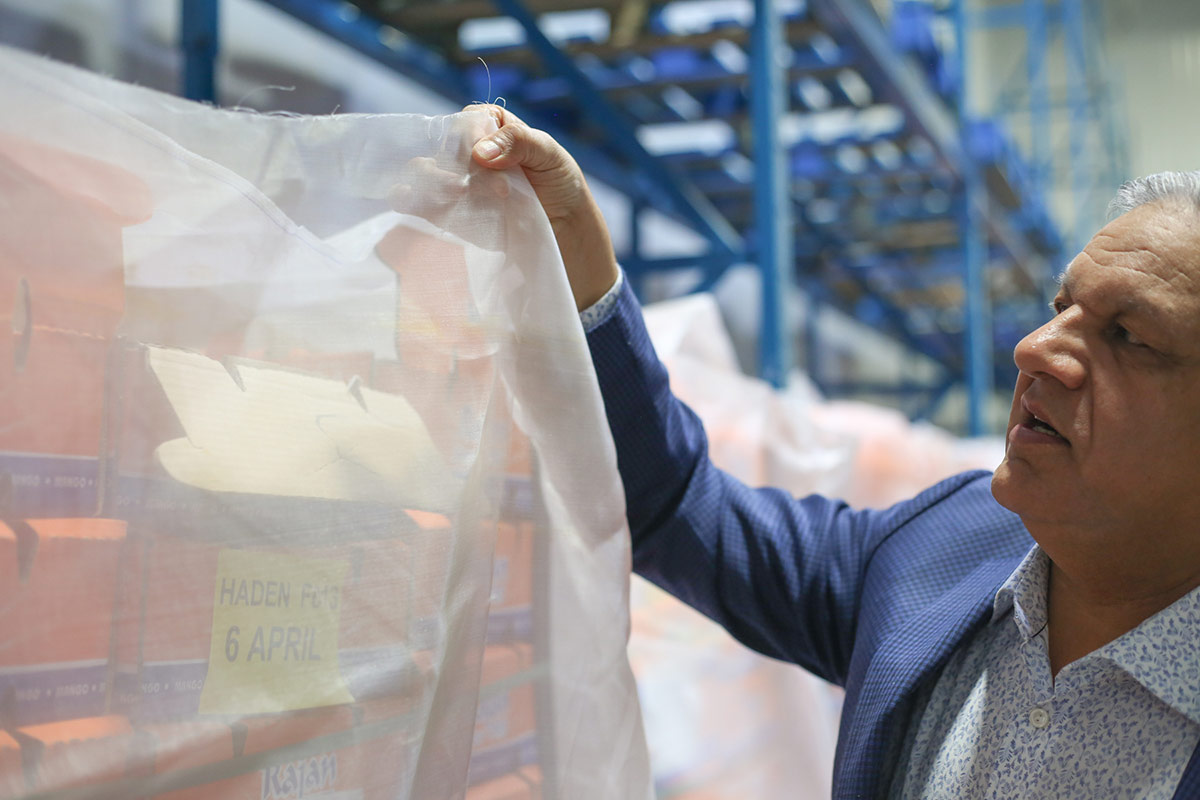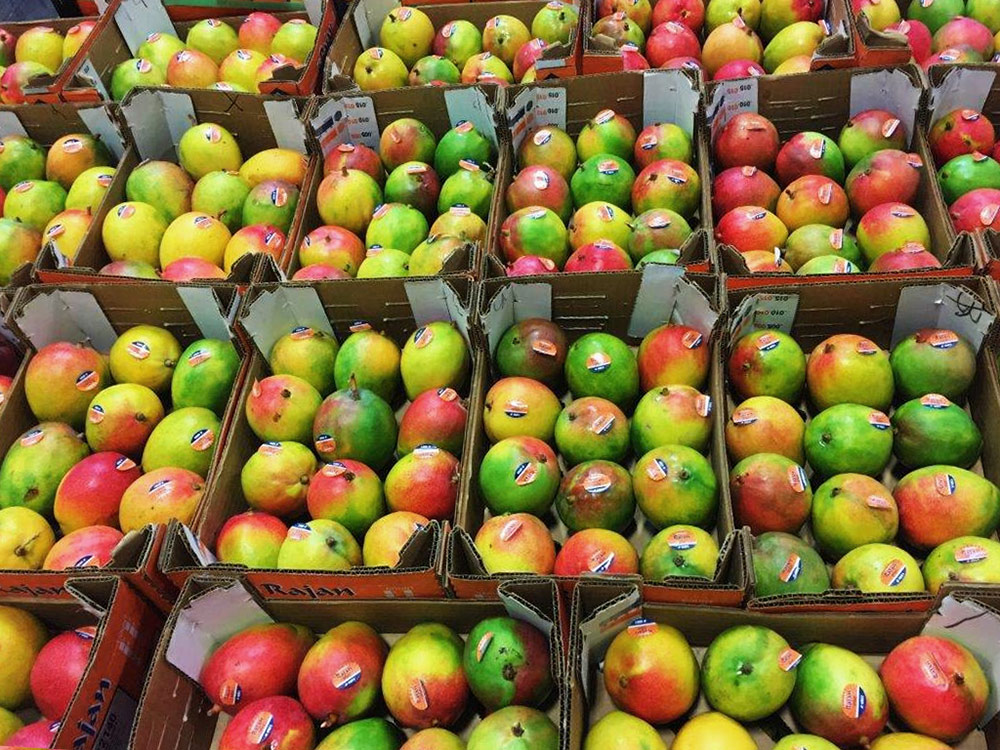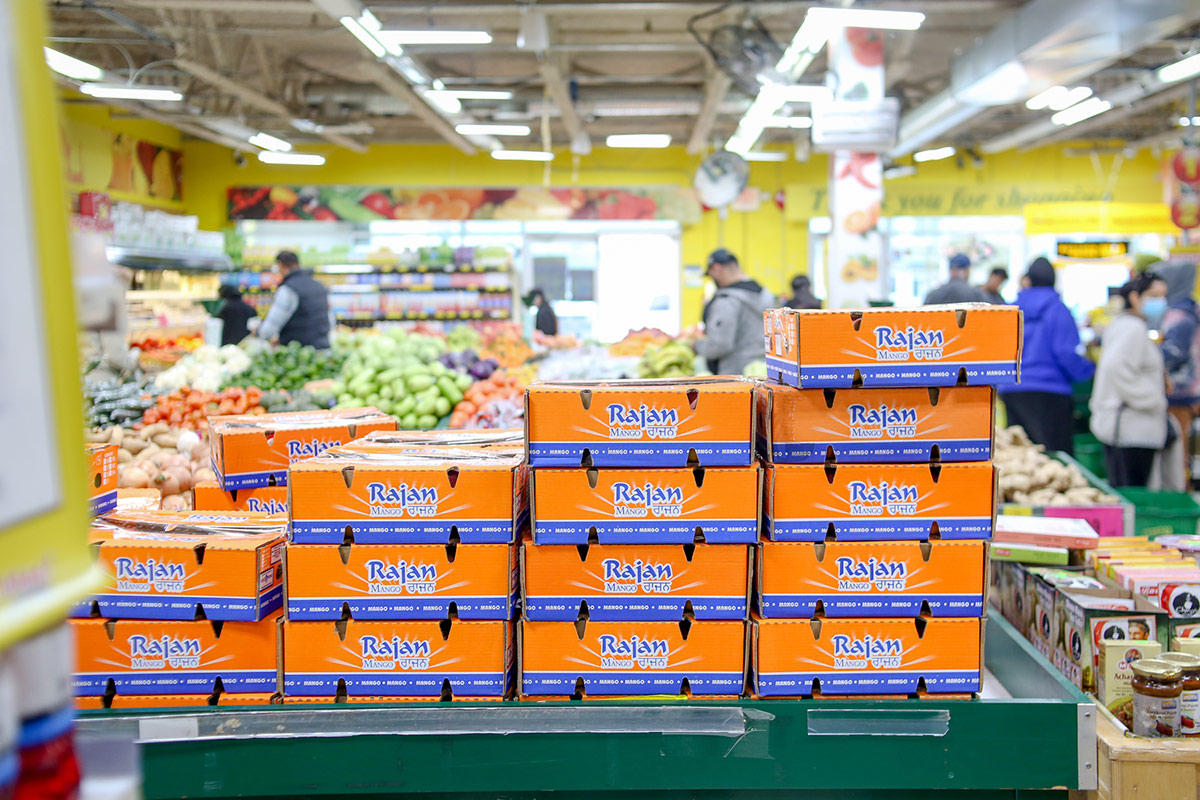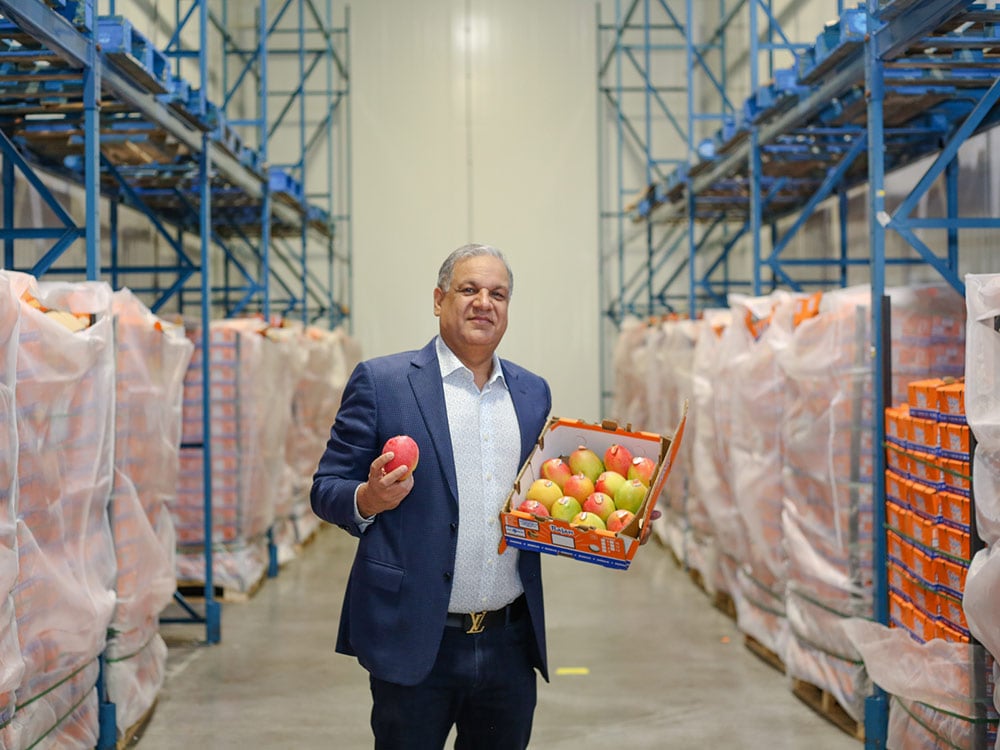Tony Singh is on his way to the mango room.
It takes a while to get there from his office even though they’re in the same building, because his cavernous warehouse in Surrey’s Newton neighbourhood is a vast 125,000 square feet. This is the headquarters of Fruiticana, the grocery chain Singh started back in 1994. He’s grown it into an 18-store empire across B.C. and Alberta, beloved by locals for fresh produce and South Asian kitchen essentials.
I’m tagging along, and we stroll down a maze of pallet racks piled to the ceiling with supermarket goodies. We pass endless rows of the latest arrival: cases upon cases of Chinese ginger.
We arrive at the entrance to the mango room, a pair of giant doors that Singh slides open. He beckons me in. Outside the walls of the warehouse, it’s a cloudy spring day in the Lower Mainland with a temperature of 17 C. But as we step into the mango room, we are suddenly in Mexico.
“The rest of the market cannot do what I do because they buy from wholesalers,” says Singh. “We keep it as natural as possible. The mangoes come in warm in the truck, and we don’t keep them in a fridge.”
In here, it’s about 28 degrees, the same temperature as it is on the orchards of the state of Michoacán, where Fruiticana’s Haden mangoes are grown.
These mangoes are the pride of Singh and his stores. There’s the fact his son shares the same name as his mango brand, Rajan, a Fruiticana exclusive. There are careful steps he’s developed to grow them, from dodging acidic mango sap to measuring the flesh’s sugar concentration. And most recently, there’s the recruitment of Diljit Dosanjh, the Indian superstar singer and actor, as Fruiticana’s ambassador. This year’s commercial features Dosanjh biting into a juicy mango at Stanley Park, with a dreamy flashback to his childhood running through orchards in India.
Singh was that young boy too, he says. Born in Jalandhar in the Indian state of Punjab, he has his own memories climbing mango trees and picking the fruit.
When his family relocated to Canada in 1975, what did 10-year-old Singh sorely miss?
“The food! The flavours!” he says. “That’s the connection I want people to have.”
The season for the Rajan Hadens lasts from mid-February to June. It takes six days for a mango picked in the orchard in Michoacán to be delivered to the mango room in Surrey. But it took Singh years to smooth out the journey from field to table and cultivate the perfect mango.
Mangoes: the first sign of spring
For some Vancouverites, the coming of spring is marked not by the end of the winter gloom and the pink blanket of cherry blossoms, but by the arrival of mangoes.
I grew up in this rainy West Coast city without a single mango tree, but I do have my own childhood mango memories — not from eating the fruit, but from eating mango cake. The city’s many Chinese bakeries like Michelle’s and Saint Germain await the arrival of the spring Ataulfos, a familiar seasonal sight in local grocery stores. Bakers slice these mangoes thinly and use them to dress their vanilla sponge cakes like giant orange petals.
I tagged along with my mother to see these beautiful works of art when they appeared in the glass display cases every spring. We ate them on Mother’s Days, and everyone from my grandmother with false teeth to my young cousins with new teeth enjoyed their softness, taking big bites and covering their lips in mango and cream.
While Ataulfos can be decent, Vancouverites who’ve lived in hotter parts of the world where mangoes are grown will know that the varieties mass-produced for North American supermarkets simply cannot compare.
In India, mangoes are the national fruit and hold deep cultural meaning. There are over 1,000 varieties, and each region’s unique cultivars are celebrated and defended by its people.
But while India grows over 45 per cent of the world’s mangoes, only one to three per cent is exported globally.
That means that Canadians looking for their beloveds from South Asia go to special lengths to get them.
It’s a bit easier in populous Ontario, but tougher in B.C. There are a few grocers in Surrey who make the effort to stock Alphonsos and kesars — and to a lesser degree, even chaunsas, Dusheris and Sindhris — but these can only be brought over by air because they ripen fast. During the pandemic, they cost about $30 for a box of six.
Outside of the grocery world, you can find some dedicated locals who band together in WhatsApp groups to pool enough money for shipments.
A good mango was hard to find
Back in 1994, when Tony Singh arrived in B.C. from Montreal, even a decent mango from Central or South America was hard to find. He was not impressed by the ones stocked by local grocers.
“They were coming in by container, and they were green, hard mangoes that had no flavour, sitting in fridges for months,” he said.
Three years after he opened his first Fruiticana in growing Surrey — to save residents from monthly trips into Vancouver to get their essentials from the Punjabi Market — he went on the hunt for a mango grower.
Importing from India would be far too expensive. He wanted a grower closer by, so he could control everything from the colour to the sweetness. That way, he wouldn’t have to get them from wholesalers, shortening the time between the picking and eating of a mango.
In 1997, Singh began driving across Mexico to visit farmers who had small orchards of about four acres. He worked with different mango growers, but it was a challenge finding the right partner and took a lot of trial and error.
“Some of the product didn’t come out right so we had to dump everything,” he said. “It was a lot of investment.”
A kingly fruit
Singh eventually came upon the grower in Michoacán that would come to grow Fruiticana’s label of Haden mangoes, a variety that was popularized a century ago by a retired Floridian army officer who gave it his name. The Haden mango has ancestry in the Malgova variety, from India, and the Turpentine, from the Caribbean.
Singh named his label Rajan, a Punjabi and Hindi word with Sanskrit roots that means “king.”
Singh, who visits the orchard twice a year, worked with his grower on every step of the mango journey.
Picking the fruit, for example, is a tricky task that requires the finesse of human hands.
“In the old days, people just hit the tree with a stick and let the mango fall on the ground. That bruises the mango,” says Singh. “It will have a mark on it, and by the time it gets to Canada, you will see that one side of the mango is black.”
Singh and the farmers developed a tool — a long stick with a hook and net — to grab the mango and catch it. Care must be taken to only pick one and not let others fall.
Then there’s the threat of mango sap. Trees can become saturated with water due to rain, causing the mangoes to release an acidic, milky-looking sap when picked that can come out in spurts.
“It becomes a very sticky glue that burns the mango. It actually burns your hand too if you leave it there for too long, due to the acidity,” said Singh.
To solve this problem, the trick is to place mangoes upside down in trays after they’ve been picked, to allow the sap to drip off.
There’s also the issue of timing. Mangoes bound for Canada are picked earlier than if they were to be eaten off the tree in Michoacán. At this stage, they’re a beautiful blend of red, orange, yellow and green: a mango in metamorphosis. Their sugar content is measured to ensure that they still have time to fully ripen and sweeten by the time a shopper picks one up from a Fruiticana.
After their six-day journey to the mango room, mangoes are delivered to Fruiticana stores the same day or the next day, “so the customer can have the same flavour as the field flavour,” says Singh.
Singh’s strategy is all about control. There are other growers in Mexico and Peru that supply Hadens to North American supermarkets, but cutting out the middlemen and getting them straight from the source sets his Rajan brand apart.
“It’s all about how quickly we move the mangoes.”


Cut to the feeling
How and when do you eat a Rajan Haden?
Singh likes them cut in slices. They’re best for this soon after they arrive, firm and fleshy, sweet and tangy.
“Some people like to wait until the mango’s really ripe, and they just make a hole at the top, squeeze the mango and just suck the mango juice,” says Singh. “That’s my mom’s favourite way.”
I’m with Singh’s mom when it comes to waiting.
These days, a four-kilogram case of the Rajan mangoes, containing about nine pieces of fruit, costs $14; $10 if you happen to catch them during the store’s Extra Extra Super Special. Take them home and they’ll fill a room with their warm fragrance as they ripen. If impatient, I’ll stick one or two in a paper bag. The mango can still breathe in there, but the bag traps the ethylene inside, a gaseous plant hormone. Many fruits like bananas and peaches give off ethylene when they ripen, speeding up the process. It’s an incredible test of patience, waiting all year for mango season, then waiting for the mangoes in your home to blush up.
Cut one open after a few days and the interior will have turned pale yellow to a dark gold. It’s a rich, complex mango with a deep flavour you can get lost in. Eat near the skin and you’ll pick up citrus notes. Eat near the centre and you’ll taste creamy coconut. The pit — the fibrous heart and soul of the fruit — is something you have to slurp by hand as juice runs down your arm.
It’s a physical experience, and after you’ve washed away the stickiness, your hands will still be perfumed with mango.
A masterpiece and a work in progress
Almost 20 years after introducing them to his stores, Singh is still trying to perfect his mangoes. He’s happy with the flavour, but is still testing how to time the picking just right for when the mangoes hit the road.
“If there’s an issue, we can pretty much track it to the day the mango is picked and which orchard it came from,” he says, pointing to the coded sticker on each case.

Singh knows how important they are to his customers, especially the ones who’ve immigrated to Canada, whether they are newcomers or have been here for 60 years. He’s noticed that the local India diaspora likes to visit their homeland in the winter, because the summers are too hot.
“But mango season is in the summertime,” said Singh. “So every time they go back, they never taste the mangoes.”
A 70-year-old man recently emailed Singh, telling him his mangoes took him back to when he was young, sitting in the shade of a mango tree.
“That’s what I was missing when I was a child here,” said Singh. “Triggering someone’s memory and have them say, ‘yes, the flavour is there, the feeling is there’ — that’s what drives me.” ![]()
Read more: Local Economy, Food
















Tyee Commenting Guidelines
Comments that violate guidelines risk being deleted, and violations may result in a temporary or permanent user ban. Maintain the spirit of good conversation to stay in the discussion.
*Please note The Tyee is not a forum for spreading misinformation about COVID-19, denying its existence or minimizing its risk to public health.
Do:
Do not: